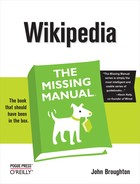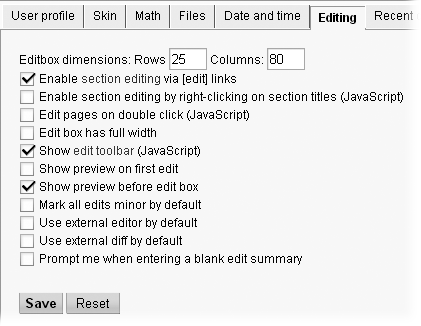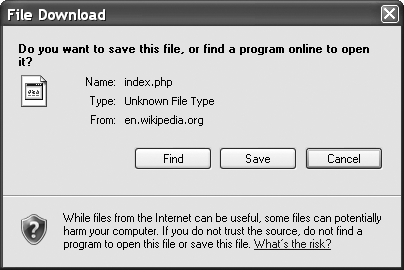The Editing tab (Figure 20-9) lets you select from among 11 options that let you tweak how edit mode looks and feels. In general, you’ll rack up several dozen hours of editing before you feel the need to play with these settings.
This tab also lets you resize the edit box. Resizing the edit box makes sense if you have an extra-wide or extra-deep screen. On the other hand, if you’re constantly having to tab down to enter an edit summary and click “Show preview” and “Save page”, you might be willing to live with fewer rows visible and a bit more scrolling to get to the text you want.
Figure 20-9. These three editing options start out turned on, and most editors leave them that way. For example, it’s very handy to be able to click a link to edit an individual article section (Editing Article Sections). So are the editing toolbar, and the preview feature.
Three of the editing tab options are initially turned on, and it’s good to leave them that way: “Enable section editing via [edit] links”, “Show edit toolbar (JavaScript)”, and “Show preview before edit box”.
The eight other options start out turned off. Whether you want to use them is up to you:
Enable section editing by right-clicking on section titles (JavaScript). If you’re one of those Windows fans who expect everything to be right-clickable, this one’s for you.
Edit pages on double click (JavaScript). This option is probably not a good idea, since it’s better to edit individual sections, not whole pages, as explained on Editing Article Sections. Besides, clicking the “edit this page” tab isn’t so hard when you want to edit an entire page.
Edit box has full width. This item widens, but doesn’t make the edit box the full screen width, because the boxes and links on the left side remain in place.
Show preview on first edit. When you go into edit mode, you see not only the edit box but also a preview of the section or page as it was before you started editing. (In other words, this option is like clicking the “Show preview” button immediately after going into edit mode, before you actually do any editing.) Mostly useful if you do a lot of work with template pages.
Mark all edits minor by default. This setting saves you from having to turn on the “This is a minor edit” box every time you edit a page. If you do lots of copyediting work—for example, correcting punctuation errors or fixing disambiguation links—it’s good to mark such edits as “minor”, so that other editors can screen them out of various lists if they want to.
If you set this option, you must remember to turn off (click) the “This is a minor edit” box whenever you make a non-minor edit.
Use external editor by default. With this option, when you click “edit this page”, or an edit link for a section, Wikipedia doesn’t go into editing mode. Instead, it calls up your browser, which offers you the chance to choose a different program in which to do your editing (Figure 20-10).
If you have a text editor that you really like to use (BBEdit, emacs, Kedit or vi for example), read more about this option at Help:External editors and Wikipedia:Text editor support.
Figure 20-10. If you set up your preferences to use an external editor instead of Wikipedia’s edit box, then the first time you start to edit a file, Wikipedia sends the file to your browser. The browser opens a dialog box for you to specify actual editing program. The dialog box varies by browser—this picture shows Internet Explorer 7.
Use external diff by default. Does the same as the previous option, but for diffs.
Prompt me when entering a blank edit summary. Once you set this option, you never have to worry about inadvertently forgetting to fill in the edit summary field. Edit summaries are very helpful to other editors reviewing a page history, as Previewing explains.


